Wende Museum
| Established | 2002 |
|---|---|
| Location | 5741 Buckingham Parkway, Suite E, Culver City, California 90230 |
| Type | Cultural Museum |
| Director | Justinian Jampol |
| Public transit access | Culver City Bus 3 and Metro Local bus 108 and 358 at Slauson Avenue/Buckingham Parkway |
| Website |
www |
The Wende Museum of the Cold War is an art museum, historical archive, and educational institution in Culver City, California.[1] It was founded in 2002 by Justinian Jampol and has a collection of more than 100,000 unique objects of visual and material culture from the Soviet Union and the former Eastern Bloc.[2] In November 2012, the City Council of Culver City voted unanimously to approve a 75-year lease of the former United States National Guard Armory building in Culver City as the permanent location of the Wende Museum. The Armory building was constructed by the National Guard in 1949, when the Cold War began to escalate, and was decommissioned in March 2011. The museum is expected to open at the Armory site in late 2016 following renovations.[3][4]
Overview
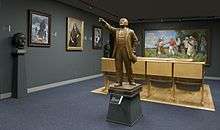
“Wende” is a German word meaning “transformation," a period of transition and change leading up to the toppling of the Berlin Wall in 1989 and the collapse of the Soviet Union in 1991.
The Museum’s East German collections are the subject of a major Taschen publication, Beyond the Wall: Art and Artifacts from the GDR/ Jenseits der Mauer. Kunst und Alltagsgegenstände aus der DDR (Cologne: TASCHEN, 2014).[5][6][7]
Mission
The Wende Museum preserves Cold War history, inspires a broad understanding of the period, and explores its enduring legacy. Named for the transformative period leading up to and following the fall of the Berlin Wall in 1989, the museum
- collects and preserves artwork, artifacts, archives, films, and personal histories from Cold War–era Eastern Europe and the Soviet Union;
- challenges and engages the public through experimental exhibitions and interdisciplinary programming inspired by the collection;
- promotes rigorous scholarship, educates students, and stimulates general interest through lectures, symposia, and publications; and
- illuminates the past and informs the present through creative collaborations with contemporary artists and designers.
Collections
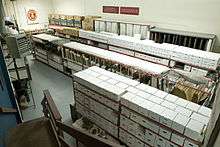
The Wende’s collections are a resource for the vanishing cultural and political history of the former East Bloc countries (Albania, Bulgaria, Czechoslovakia, East Germany, Hungary, Poland, Romania) and the Soviet Union.[8] The Wende uses cutting-edge museum and archival models to support emerging fields of academic study in visual and material culture studies as well as cultural history. The museum promotes a multi-layered exploration and discussion of the Cold War era.[9]
The ever-increasing collection widely ranges from consumer products (e.g., computers, radios, records, toiletries, foodstuff) to works of art in all media (e.g., paintings, drawings, sculptures, graphics, photographs), iconic political symbols (e.g., statuary, medals, flags, uniforms, commemorative gifts), and archives — including a substantial gift from East German leader Erich Honecker’s estate — and some 3,500 16 mm documentary, animation, and educational films as well as home movies from the GDR.[10] The museum contains large collections of furniture, flags and banners, commemorative plates, Communist folk art, menus, family albums, and design items. The museum recently acquired a significant collection of Hungarian Cold War–era artworks and artifacts and Russian hippie materials from the 1960s and 1970s.[11]
The Wende Museum owns eleven original segments of the Berlin Wall, including ten pieces installed in front of 5900 Wilshire Boulevard, the longest stretch of the Wall outside Germany. The eleventh, painted by Berlin-based artist Thierry Noir, stands in front of the museum’s headquarters in Culver City.
Although comprehensive in nature, the collection shows notable strength in four areas:
- materials originating from East Germany, with more than 50% of the collection from the GDR;
- items used in everyday life and holdings capturing lived experience;
- materials that document "Wende Moments", or junctures in Cold War history marked by extreme change—beginnings, endings, and transformative events such as the formation of the Warsaw Pact, the fall of the Berlin Wall, German reunification, and the collapse of the Soviet Union; and
- official and unofficial artwork.
The Albanian Human Rights Project recently deposited its archive at The Wende Museum, including more than 70 filmed historical witness interviews with survivors of the Albanian communist purges, many of whom lived in prisons and forced labor camps for up to several decades.
The museum’s collections have been exhibited, or are currently on display, in a number of other museums and institutions, including the Los Angeles County Museum of Art, Imperial War Museum (London), Harry S. Truman Presidential Library and Museum (Independence, MO), Ronald Reagan Presidential Library (Simi Valley, CA), Gerald Ford Presidential Library (Ann Arbor, MI), the Goethe Institute (Washington, D.C.), the International Spy Museum (Washington, D.C.), the Neutra VDL Studio and Residences (Los Angeles), and the El Segundo Museum of Art (El Segundo, CA).[12]
Programs
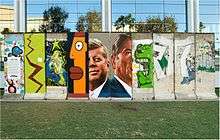
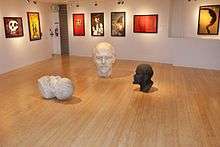
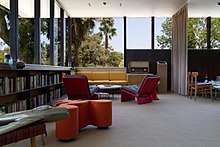
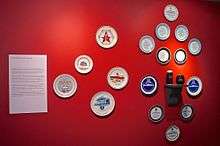
The museum initiates programs that provide resources and opportunities for individual interpretation of the past and for discovering the global implications of the Cold War today. The museum also uses the period as a lens to explore parallels and metaphors that reflect on contemporary life, human behavior, and creative expression.
- The Wall Project
- The Surveillance Project
- Across/the Wall
- Deconstructing Perestroika
- Competing Utopias
- Communism for Dinner
- Face to Face
In 2009, the Wende Museum commemorated the 20th anniversary of the fall of the Berlin Wall with The Wall Project, the most ambitious commemoration outside of Germany.[13] As part of the event, the museum installed ten original segments of the Berlin Wall in front of 5900 Wilshire Boulevard, the longest stretch of the Wall in the United States.[14] “The Wall Across Wilshire,” an artistic interpretation of a temporary wall closing down Wilshire Boulevard on the night of November 8, 2009, was painted by the public and by visual artists, among them Shepard Fairey and a group of graffiti artists working with ArtStorm.
As part of The Wall Project, the Western sides of the Berlin Wall pieces were painted by LA muralist Kent Twitchell, Thierry Noir, and emerging Los Angeles artists Farrah Karapetian and Marie Astrid Gonzalez.[15][16] In addition to the new works, one of the pieces retains the original painting by Berlin street artist Bimer, who is known for his renderings of bears.[17]
On November 13, 2011, the museum unveiled Behind The Wall, a component of The Surveillance Project that brought together street artists D*Face, RETNA, and Herakut to paint the original east-facing backs of the wall pieces on Wilshire Boulevard.[18]
Also in 2011, as part of the Downtown Art Walk, the museum mounted Across/ the Wall, an exhibition on the exterior wall of a parking garage with high-resolution reproductions of Soviet-era portraits.[19] While street artists started to exhibit in museums such as the Los Angeles Museum of Contemporary Art (MOCA), this street project brought museum art onto the streets of downtown Los Angeles.
In collaboration with the Craft and Folk Art Museum in Los Angeles, The Wende Museum mounted Deconstructing Perestroika from January 28 to May 6, 2012.[20] The exhibit showcased 24 original, hand-painted poster designs created by thirteen artists as visual responses to Mikhail Gorbachev’s transformative policies of Glasnost and Perestroika in the late 1980s. This exhibition, culled from the museum’s Ferris Collection of 234 poster designs, examined key political and cultural shifts that defined the era and that ultimately undermined the very foundation of Soviet ideology. In 2013, this exhibit traveled to the Natalie and James Thompson Art Gallery at San Jose State University.
In 2013, The Wende Museum also contributed artifacts from their collection, including Russian vouchers, to Jeremy Deller's solo exhibition in the British Pavilion at the Venice Biennale.[21]
From July to September 2014, The Wende Museum, in collaboration with the Neutra VDL Studio and Residences, organized an experimental installation of its East German modern furniture and everyday objects in the Neutra House, an iconic mid-century example of modern California architecture by Austrian-born American architect Richard Neutra, under the title Competing Utopias. The aim of the installation was to provoke questions about cultural parallels between the antagonistic power blocs of the Cold War. [22][23]
From March to May 2015, The Wende Museum showcased the exhibition Communism for Dinner, featuring 130 pieces from its collection of 1,200 commemorative plates, mostly from the GDR. Commemorative plates typically honor the role of individuals or political organizations in building up a socialist society, but they also exhibit the cracks between official ideology and everyday life.[24][25]
From June to September 2015, the Wende exhibited Face to Face, a selection of painted and photographed portraits from the Soviet Union, Cold War Hungary, and East Germany. The exhibition covers the whole range from Socialist Realist portraits of Heroes of Soviet Labor to semi-official and unofficial portraiture, including the very fringes of socialist society.[26][27]
References
- ↑ Wende Museum History
- ↑ "Humanities Magazine - California's Cold War Museum: An Exceptional Look at Everyday Life at the Wende Museum - NEH.gov". National Endowment for the Humanities. May–June 2011.
- ↑ "Culver City's Cold War museum is hoping for a victory - LATimes.com". Los Angeles Times. November 11, 2012.
- ↑ "Culver City approves Cold War museum's lease for new home - LATimes.com". Los Angeles Times. November 14, 2012.
- ↑ http://www.metropolismag.com/February-2015/Cold-War-Culture/ New York Times - "DDR Posters" and "Beyond the Wall"
- ↑ "Beyond the Wall: Art and artifacts from the GDR"
- ↑ Los Angeles Times - Culver City's Cold War museum remembers the Berlin Wall's fall
- ↑ "Humanities Magazine - California's Cold War Museum: An Exceptional Look at Everyday Life at the Wende Museum - NEH.gov". National Endowment for the Humanities. May–June 2011.
- ↑ The Atlantic "Cold War Relics: The Wende Museum Saves Communist Design"
- ↑ The Atlantic - Cold War Relics: The Wende Museum Saves Communist Design - theatlantic.com
- ↑ The Wall Street Journal - An Auction for Budapest's Bourgeoisie Puts Lenin on the Communist Block - WSJ.com
- ↑ Easy Reader News - Here Today, Gone Tomorrow-"Fame" in El Segundo, explores the renowned and the forgotten in a new exhibition
- ↑ Los Angeles Times - Berlin Wall's fall will be memorialized across Wilshire
- ↑ PRI's The World - Preserving the Cold War in Sunny California
- ↑ Los Angeles Times - When the two halves of Berlin became whole again
- ↑ Los Angeles Magazine - Berlin Wall Was Falling Down
- ↑ The Wende Museum - The Wall Project
- ↑ Los Angeles Times - United through a Berlin Wall artwork
- ↑ Art Walk - The Wende Museum
- ↑ Los Angeles Times - Poster art exhibit recalls end of Soviet era
- ↑ The Guardian - Jeremy Deller shows a 'wistfully aggressive' Britain at Venice Biennale
- ↑ Los Angeles Times - West Coast meets Eastern Bloc in "Competing Utopias" exhibition
- ↑ New York Times - Where the Curtains Were Made of Iron
- ↑ Los Angeles Magazine - Dinner with a Side of Lenin
- ↑ The Wende Museum - Communism for Dinner
- ↑ BlouinArtInfoBlogs - Nathan Farb's Faces of the Cold War
- ↑
External links
| Wikimedia Commons has media related to Wende Museum. |
Coordinates: 33°59′27″N 118°22′56″W / 33.9909°N 118.3822°W